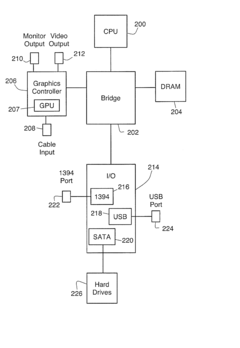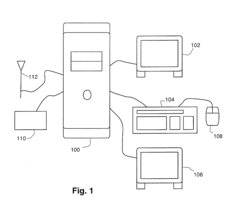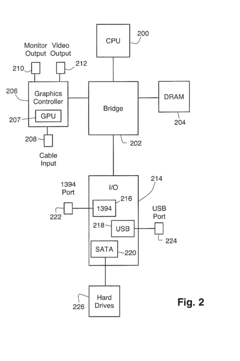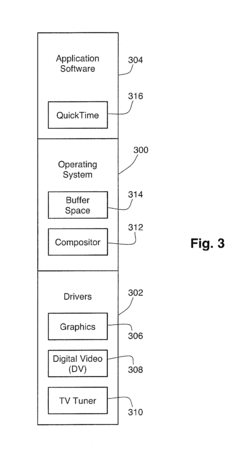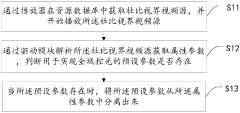Dolby Vision’s Role in Innovative Computer Graphics Renderings
JUL 30, 20259 MIN READ
Generate Your Research Report Instantly with AI Agent
Patsnap Eureka helps you evaluate technical feasibility & market potential.
Dolby Vision Evolution
Dolby Vision has undergone significant evolution since its inception, transforming the landscape of computer graphics rendering. Initially introduced as a high dynamic range (HDR) imaging technology for cinema and home entertainment, Dolby Vision has expanded its reach into the realm of innovative computer graphics.
The journey of Dolby Vision began with its focus on enhancing the visual experience in traditional media. It offered superior color depth, brightness, and contrast compared to standard dynamic range (SDR) formats. As the technology matured, it found applications beyond conventional displays, venturing into the domain of computer-generated imagery (CGI) and real-time rendering.
In the early stages, Dolby Vision's implementation in computer graphics was limited to post-processing techniques. It primarily served to enhance the final output of rendered images, adding HDR effects to improve visual fidelity. However, as computational power increased and rendering techniques advanced, Dolby Vision's role in the graphics pipeline became more integral.
The integration of Dolby Vision into real-time rendering engines marked a significant milestone. This development allowed for dynamic HDR adjustments during the rendering process, enabling more accurate representation of lighting, reflections, and color gradients. Game engines and visualization software began incorporating Dolby Vision capabilities, leading to more immersive and visually striking experiences.
As the technology progressed, Dolby Vision's influence extended to the asset creation stage of computer graphics. Artists and designers started considering HDR color spaces and dynamic range from the outset, tailoring their workflows to take full advantage of Dolby Vision's capabilities. This shift in approach resulted in more vibrant and lifelike digital environments and characters.
The evolution of Dolby Vision also saw its adaptation to various display technologies. From OLED to quantum dot displays, the technology has been optimized to leverage the unique characteristics of different screen types, ensuring consistent and high-quality visual output across diverse platforms.
Recent advancements have focused on real-time tone mapping and color grading within the Dolby Vision framework. These developments have empowered content creators with unprecedented control over the final look of their rendered graphics, allowing for nuanced adjustments that were previously only possible in post-production.
Looking ahead, Dolby Vision continues to evolve, with ongoing research into machine learning-assisted rendering and adaptive HDR techniques. These innovations promise to further enhance the role of Dolby Vision in pushing the boundaries of what's possible in computer graphics rendering, paving the way for even more realistic and visually stunning digital experiences.
The journey of Dolby Vision began with its focus on enhancing the visual experience in traditional media. It offered superior color depth, brightness, and contrast compared to standard dynamic range (SDR) formats. As the technology matured, it found applications beyond conventional displays, venturing into the domain of computer-generated imagery (CGI) and real-time rendering.
In the early stages, Dolby Vision's implementation in computer graphics was limited to post-processing techniques. It primarily served to enhance the final output of rendered images, adding HDR effects to improve visual fidelity. However, as computational power increased and rendering techniques advanced, Dolby Vision's role in the graphics pipeline became more integral.
The integration of Dolby Vision into real-time rendering engines marked a significant milestone. This development allowed for dynamic HDR adjustments during the rendering process, enabling more accurate representation of lighting, reflections, and color gradients. Game engines and visualization software began incorporating Dolby Vision capabilities, leading to more immersive and visually striking experiences.
As the technology progressed, Dolby Vision's influence extended to the asset creation stage of computer graphics. Artists and designers started considering HDR color spaces and dynamic range from the outset, tailoring their workflows to take full advantage of Dolby Vision's capabilities. This shift in approach resulted in more vibrant and lifelike digital environments and characters.
The evolution of Dolby Vision also saw its adaptation to various display technologies. From OLED to quantum dot displays, the technology has been optimized to leverage the unique characteristics of different screen types, ensuring consistent and high-quality visual output across diverse platforms.
Recent advancements have focused on real-time tone mapping and color grading within the Dolby Vision framework. These developments have empowered content creators with unprecedented control over the final look of their rendered graphics, allowing for nuanced adjustments that were previously only possible in post-production.
Looking ahead, Dolby Vision continues to evolve, with ongoing research into machine learning-assisted rendering and adaptive HDR techniques. These innovations promise to further enhance the role of Dolby Vision in pushing the boundaries of what's possible in computer graphics rendering, paving the way for even more realistic and visually stunning digital experiences.
Market Demand Analysis
The market demand for Dolby Vision in innovative computer graphics renderings has been experiencing significant growth in recent years. This surge is primarily driven by the increasing consumer appetite for high-quality visual experiences across various platforms, including streaming services, gaming, and virtual reality applications.
In the streaming sector, major players like Netflix, Amazon Prime, and Disney+ have been rapidly adopting Dolby Vision technology to enhance their content offerings. This adoption is a direct response to viewers' demands for more immersive and lifelike visual experiences. The ability of Dolby Vision to deliver superior HDR (High Dynamic Range) content with enhanced contrast, brightness, and color accuracy has become a key differentiator in the competitive streaming landscape.
The gaming industry has also shown a strong interest in Dolby Vision technology. As next-generation consoles and high-end gaming PCs continue to push the boundaries of graphical fidelity, there is a growing demand for rendering technologies that can fully utilize these advanced hardware capabilities. Dolby Vision's ability to provide more vibrant and realistic graphics aligns perfectly with gamers' expectations for increasingly immersive experiences.
In the realm of virtual and augmented reality, Dolby Vision's potential to enhance visual quality is particularly promising. As these technologies continue to evolve and find applications in various sectors such as education, healthcare, and entertainment, the demand for high-fidelity rendering solutions is expected to grow substantially.
The professional content creation industry, including film and television production, has also shown a keen interest in Dolby Vision. The technology's capacity to capture and display a wider range of colors and contrasts is particularly valuable in post-production workflows, allowing creators to achieve their artistic vision with greater precision.
Market analysts predict that the global HDR market, of which Dolby Vision is a significant part, will continue to expand at a compound annual growth rate (CAGR) of over 15% in the coming years. This growth is expected to be fueled not only by consumer demand but also by the increasing availability of Dolby Vision-compatible devices, including televisions, monitors, and mobile devices.
However, it's important to note that the market demand for Dolby Vision in computer graphics renderings is not without challenges. The technology requires specialized hardware and software support, which can increase production costs. Additionally, there is competition from other HDR formats, such as HDR10+ and HLG, which may impact Dolby Vision's market share in certain segments.
In the streaming sector, major players like Netflix, Amazon Prime, and Disney+ have been rapidly adopting Dolby Vision technology to enhance their content offerings. This adoption is a direct response to viewers' demands for more immersive and lifelike visual experiences. The ability of Dolby Vision to deliver superior HDR (High Dynamic Range) content with enhanced contrast, brightness, and color accuracy has become a key differentiator in the competitive streaming landscape.
The gaming industry has also shown a strong interest in Dolby Vision technology. As next-generation consoles and high-end gaming PCs continue to push the boundaries of graphical fidelity, there is a growing demand for rendering technologies that can fully utilize these advanced hardware capabilities. Dolby Vision's ability to provide more vibrant and realistic graphics aligns perfectly with gamers' expectations for increasingly immersive experiences.
In the realm of virtual and augmented reality, Dolby Vision's potential to enhance visual quality is particularly promising. As these technologies continue to evolve and find applications in various sectors such as education, healthcare, and entertainment, the demand for high-fidelity rendering solutions is expected to grow substantially.
The professional content creation industry, including film and television production, has also shown a keen interest in Dolby Vision. The technology's capacity to capture and display a wider range of colors and contrasts is particularly valuable in post-production workflows, allowing creators to achieve their artistic vision with greater precision.
Market analysts predict that the global HDR market, of which Dolby Vision is a significant part, will continue to expand at a compound annual growth rate (CAGR) of over 15% in the coming years. This growth is expected to be fueled not only by consumer demand but also by the increasing availability of Dolby Vision-compatible devices, including televisions, monitors, and mobile devices.
However, it's important to note that the market demand for Dolby Vision in computer graphics renderings is not without challenges. The technology requires specialized hardware and software support, which can increase production costs. Additionally, there is competition from other HDR formats, such as HDR10+ and HLG, which may impact Dolby Vision's market share in certain segments.
Technical Challenges
Dolby Vision's integration into computer graphics rendering presents several significant technical challenges. The primary obstacle lies in the complexity of implementing High Dynamic Range (HDR) and Wide Color Gamut (WCG) capabilities within existing rendering pipelines. Traditional rendering systems are often optimized for Standard Dynamic Range (SDR) content, making the transition to HDR a non-trivial task.
One of the key challenges is the accurate representation and manipulation of high bit-depth color data throughout the rendering process. Dolby Vision requires 12-bit color depth, which significantly increases the computational demands and memory requirements compared to standard 8-bit or 10-bit workflows. This necessitates substantial modifications to rendering engines and graphics hardware to handle the expanded color space and luminance range effectively.
Another critical issue is the management of tone mapping and color grading in real-time rendering scenarios. Dolby Vision's dynamic metadata allows for scene-by-scene and even frame-by-frame optimization of HDR content. Implementing this level of granular control in a real-time rendering environment poses significant challenges, particularly in maintaining consistent visual quality across different display devices with varying capabilities.
The integration of Dolby Vision also introduces complexities in the area of performance optimization. The increased data processing requirements for HDR content can lead to performance bottlenecks, especially in real-time applications such as video games or interactive visualizations. Balancing the enhanced visual fidelity of Dolby Vision with maintaining acceptable frame rates and responsiveness is a delicate technical challenge that requires innovative optimization techniques.
Furthermore, the accurate simulation of HDR lighting and materials in computer graphics renderings presents its own set of challenges. Replicating the nuanced behavior of light in high-contrast scenarios and accurately representing a wide range of material properties under HDR conditions requires sophisticated physically-based rendering techniques. This often necessitates the development of new shading models and lighting algorithms that can faithfully reproduce the expanded dynamic range and color gamut of Dolby Vision.
Lastly, ensuring compatibility and consistent visual experience across different display technologies and viewing environments remains a significant challenge. The varying capabilities of HDR displays, from high-end professional monitors to consumer-grade televisions, require careful consideration in the rendering process to maintain the intended visual impact of Dolby Vision content across diverse viewing scenarios.
One of the key challenges is the accurate representation and manipulation of high bit-depth color data throughout the rendering process. Dolby Vision requires 12-bit color depth, which significantly increases the computational demands and memory requirements compared to standard 8-bit or 10-bit workflows. This necessitates substantial modifications to rendering engines and graphics hardware to handle the expanded color space and luminance range effectively.
Another critical issue is the management of tone mapping and color grading in real-time rendering scenarios. Dolby Vision's dynamic metadata allows for scene-by-scene and even frame-by-frame optimization of HDR content. Implementing this level of granular control in a real-time rendering environment poses significant challenges, particularly in maintaining consistent visual quality across different display devices with varying capabilities.
The integration of Dolby Vision also introduces complexities in the area of performance optimization. The increased data processing requirements for HDR content can lead to performance bottlenecks, especially in real-time applications such as video games or interactive visualizations. Balancing the enhanced visual fidelity of Dolby Vision with maintaining acceptable frame rates and responsiveness is a delicate technical challenge that requires innovative optimization techniques.
Furthermore, the accurate simulation of HDR lighting and materials in computer graphics renderings presents its own set of challenges. Replicating the nuanced behavior of light in high-contrast scenarios and accurately representing a wide range of material properties under HDR conditions requires sophisticated physically-based rendering techniques. This often necessitates the development of new shading models and lighting algorithms that can faithfully reproduce the expanded dynamic range and color gamut of Dolby Vision.
Lastly, ensuring compatibility and consistent visual experience across different display technologies and viewing environments remains a significant challenge. The varying capabilities of HDR displays, from high-end professional monitors to consumer-grade televisions, require careful consideration in the rendering process to maintain the intended visual impact of Dolby Vision content across diverse viewing scenarios.
Current Implementation
01 High Dynamic Range (HDR) rendering techniques
Dolby Vision graphics rendering employs advanced HDR techniques to enhance image quality. This includes methods for processing and displaying a wider range of colors and brightness levels, resulting in more vibrant and lifelike visuals. The technology adapts to different display capabilities, ensuring optimal performance across various devices.- High Dynamic Range (HDR) rendering techniques: Dolby Vision graphics rendering employs advanced HDR techniques to enhance image quality. This includes methods for tone mapping, color grading, and dynamic range expansion to deliver more vibrant and lifelike visuals across various display devices.
- Real-time graphics processing for Dolby Vision: Implementations focus on optimizing real-time graphics processing for Dolby Vision content. This involves efficient algorithms for color space conversion, metadata handling, and adaptive rendering to ensure smooth playback and consistent visual quality across different hardware configurations.
- Display-specific optimization for Dolby Vision: Techniques for adapting Dolby Vision content to various display technologies, including OLED, LCD, and projection systems. This involves methods for local dimming, color volume mapping, and brightness adjustment to maximize the visual impact on each specific display type.
- Content creation tools for Dolby Vision: Development of specialized software tools and plugins for content creators to produce and edit Dolby Vision-compatible graphics. These tools facilitate the creation of HDR assets, manage color workflows, and provide preview capabilities for Dolby Vision output across different target devices.
- Dolby Vision compatibility with legacy content: Methods for enhancing and converting standard dynamic range (SDR) or non-Dolby Vision HDR content to be compatible with Dolby Vision displays. This includes upscaling techniques, color gamut expansion, and dynamic metadata generation to improve the viewing experience of legacy content on Dolby Vision-enabled devices.
02 Color space conversion and mapping
Efficient color space conversion and mapping are crucial for Dolby Vision graphics rendering. This involves transforming color data between different color spaces and adapting content to the specific capabilities of the display device. Advanced algorithms are used to preserve color accuracy and maintain the creator's intent across various viewing conditions.Expand Specific Solutions03 Real-time graphics processing and optimization
Dolby Vision graphics rendering incorporates real-time processing techniques to optimize performance. This includes methods for efficient GPU utilization, parallel processing, and adaptive rendering based on scene complexity. These optimizations ensure smooth playback and responsiveness, particularly important for gaming and interactive applications.Expand Specific Solutions04 Tone mapping and dynamic range adaptation
Advanced tone mapping algorithms are employed in Dolby Vision graphics rendering to adapt content to different display capabilities. This involves intelligently adjusting brightness, contrast, and color to preserve detail in both highlights and shadows. The technology can dynamically adjust these parameters based on the content and viewing environment.Expand Specific Solutions05 Content metadata processing and utilization
Dolby Vision graphics rendering makes extensive use of content metadata to enhance the viewing experience. This includes processing and interpreting metadata related to color grading, dynamic range, and creative intent. The rendering system uses this information to optimize the final output, ensuring that the content is displayed as intended across different devices and viewing conditions.Expand Specific Solutions
Key Industry Players
The competitive landscape for Dolby Vision's role in innovative computer graphics renderings is evolving rapidly, with the market in a growth phase. As the demand for high-quality visual experiences increases across various sectors, including entertainment, gaming, and virtual reality, the market size is expanding significantly. Technologically, the field is advancing quickly, with companies like Dolby Laboratories, NVIDIA, and Disney Enterprises leading the way. These firms are investing heavily in research and development to enhance rendering techniques, color accuracy, and overall visual fidelity. Other players like Sony Interactive Entertainment, Valve, and Microsoft are also making significant contributions, particularly in the gaming and entertainment sectors. The competition is fierce, with each company striving to differentiate its offerings through proprietary technologies and partnerships.
Dolby Laboratories Licensing Corp.
Technical Solution: Dolby Vision technology plays a crucial role in innovative computer graphics renderings by enhancing the visual quality of digital content. It utilizes dynamic metadata to optimize each frame or scene, allowing for a wider color gamut, higher contrast ratios, and increased brightness levels[1]. This results in more lifelike and immersive images with improved detail in both bright and dark areas. Dolby Vision supports up to 12-bit color depth, enabling the display of over 68 billion colors, significantly more than standard HDR10[2]. The technology also incorporates advanced algorithms for tone mapping, which intelligently adjusts the content to match the capabilities of different display devices, ensuring consistent quality across various screens[3].
Strengths: Superior image quality, wide device compatibility, and adaptive optimization. Weaknesses: Requires specialized hardware support and content creation tools, potentially increasing production costs.
NVIDIA Corp.
Technical Solution: NVIDIA's approach to innovative computer graphics renderings incorporates Dolby Vision through their GPU technology. Their RTX series graphics cards support Dolby Vision HDR, enabling real-time ray tracing and AI-enhanced graphics processing[4]. NVIDIA's DLSS (Deep Learning Super Sampling) technology, when combined with Dolby Vision, allows for higher resolution rendering with improved performance. The company's GPUs can process Dolby Vision metadata in real-time, adjusting color, contrast, and brightness dynamically[5]. NVIDIA also provides developers with tools like NVIDIA Nsight Graphics, which supports Dolby Vision workflows, enabling easier integration of the technology into games and applications[6].
Strengths: Powerful hardware acceleration, extensive developer support, and integration with cutting-edge AI technologies. Weaknesses: High-end solutions can be expensive, and full utilization may require specific software optimizations.
Core Innovations
Color correction of digital video images using a programmable graphics processing unit
PatentInactiveUS20080012870A1
Innovation
- The system leverages the graphics processing unit (GPU) to decode each frame of video streams, associate color profiles, and perform real-time color conversions from source color spaces to a defined working color space, and then to the display device's color space using fragment processing capabilities.
Image processing method based on backlight adjustment, smart television and storage medium
PatentActiveCN109640155A
Innovation
- By analyzing the attribute parameters of the Dolby Vision video source, it is determined whether the preset parameters exist, and mapped according to the preset switch and grayscale value, and the PWM dimming duty cycle is adjusted to set the backlight value to achieve smooth transition changes in the backlight.
Integration Strategies
Integrating Dolby Vision into computer graphics rendering pipelines requires a strategic approach to maximize its potential for enhancing visual quality and user experience. One key integration strategy is to implement Dolby Vision at the rendering engine level, allowing for real-time HDR processing throughout the entire graphics pipeline. This approach ensures that the full dynamic range and color gamut capabilities of Dolby Vision are utilized from the initial rendering stages to final output.
Another crucial strategy involves developing custom shaders and post-processing effects that leverage Dolby Vision's advanced color mapping and tone mapping algorithms. These specialized shaders can dynamically adjust contrast, brightness, and color saturation based on the content and display capabilities, resulting in more vibrant and lifelike images across a wide range of devices.
Collaboration with hardware manufacturers is essential for seamless integration. Working closely with GPU vendors to optimize drivers and hardware acceleration for Dolby Vision processing can significantly improve performance and efficiency. This partnership can lead to the development of dedicated hardware modules or optimized instruction sets that accelerate Dolby Vision computations, reducing the overall rendering overhead.
Content creators and game developers play a vital role in the integration process. Providing them with tools and guidelines for authoring Dolby Vision-compatible assets ensures that the technology's benefits are fully realized. This includes developing plug-ins for popular 3D modeling and animation software, as well as creating documentation and best practices for optimizing textures, lighting, and materials for Dolby Vision rendering.
Cross-platform compatibility is another critical aspect of integration. Implementing a flexible Dolby Vision pipeline that can adapt to various display technologies and operating systems ensures widespread adoption. This involves creating abstraction layers that can handle different color spaces, bit depths, and display characteristics while maintaining consistent visual quality across platforms.
Lastly, integrating Dolby Vision with existing industry standards and workflows is crucial for its widespread adoption. This includes developing conversion tools and pipelines that allow seamless transition between standard dynamic range (SDR) and Dolby Vision HDR content, as well as ensuring compatibility with popular file formats and color management systems used in the computer graphics industry.
Another crucial strategy involves developing custom shaders and post-processing effects that leverage Dolby Vision's advanced color mapping and tone mapping algorithms. These specialized shaders can dynamically adjust contrast, brightness, and color saturation based on the content and display capabilities, resulting in more vibrant and lifelike images across a wide range of devices.
Collaboration with hardware manufacturers is essential for seamless integration. Working closely with GPU vendors to optimize drivers and hardware acceleration for Dolby Vision processing can significantly improve performance and efficiency. This partnership can lead to the development of dedicated hardware modules or optimized instruction sets that accelerate Dolby Vision computations, reducing the overall rendering overhead.
Content creators and game developers play a vital role in the integration process. Providing them with tools and guidelines for authoring Dolby Vision-compatible assets ensures that the technology's benefits are fully realized. This includes developing plug-ins for popular 3D modeling and animation software, as well as creating documentation and best practices for optimizing textures, lighting, and materials for Dolby Vision rendering.
Cross-platform compatibility is another critical aspect of integration. Implementing a flexible Dolby Vision pipeline that can adapt to various display technologies and operating systems ensures widespread adoption. This involves creating abstraction layers that can handle different color spaces, bit depths, and display characteristics while maintaining consistent visual quality across platforms.
Lastly, integrating Dolby Vision with existing industry standards and workflows is crucial for its widespread adoption. This includes developing conversion tools and pipelines that allow seamless transition between standard dynamic range (SDR) and Dolby Vision HDR content, as well as ensuring compatibility with popular file formats and color management systems used in the computer graphics industry.
Performance Metrics
Performance metrics play a crucial role in evaluating the effectiveness and efficiency of Dolby Vision in computer graphics renderings. These metrics provide quantitative measures to assess the visual quality, processing speed, and overall impact of Dolby Vision technology on the rendering pipeline.
One of the primary performance metrics for Dolby Vision in computer graphics is image quality. This includes measures such as peak brightness, color gamut coverage, and contrast ratio. Dolby Vision's high dynamic range (HDR) capabilities allow for significantly higher peak brightness levels, often exceeding 1000 nits, compared to standard dynamic range (SDR) displays. The expanded color gamut coverage, typically reaching over 90% of the Rec. 2020 color space, enables more vibrant and accurate color reproduction.
Processing time is another critical metric, as it directly impacts the feasibility of real-time rendering applications. Dolby Vision's encoding and decoding processes introduce additional computational overhead, which must be carefully optimized to maintain acceptable frame rates. Benchmarks measuring the time required for Dolby Vision metadata generation, tone mapping, and color volume transformation are essential for evaluating overall system performance.
Memory usage is an important consideration, particularly for mobile and embedded systems. The additional metadata and processing requirements of Dolby Vision can increase memory footprint, necessitating efficient memory management strategies. Metrics tracking peak memory usage and memory bandwidth utilization help developers optimize their implementations for various hardware configurations.
Power consumption is a key metric, especially for battery-powered devices. The enhanced processing demands of Dolby Vision can lead to increased power draw, which must be balanced against the improved visual experience. Measurements of power consumption under various rendering scenarios provide valuable insights for optimizing energy efficiency.
Compatibility and interoperability metrics are crucial for assessing Dolby Vision's performance across different display technologies and content delivery systems. These metrics evaluate how well Dolby Vision content renders on various display types, including OLED, LCD, and projection systems, as well as its performance across different content delivery platforms such as streaming services and gaming consoles.
User experience metrics, while more subjective, are equally important in evaluating Dolby Vision's performance. These may include measures of perceived image quality, visual comfort during extended viewing sessions, and overall user satisfaction. Controlled studies comparing Dolby Vision renderings to traditional SDR or other HDR formats can provide valuable insights into the technology's real-world impact.
By comprehensively analyzing these performance metrics, developers and content creators can optimize their use of Dolby Vision in computer graphics renderings, ensuring that the technology's benefits are fully realized while minimizing potential drawbacks in terms of processing overhead and resource utilization.
One of the primary performance metrics for Dolby Vision in computer graphics is image quality. This includes measures such as peak brightness, color gamut coverage, and contrast ratio. Dolby Vision's high dynamic range (HDR) capabilities allow for significantly higher peak brightness levels, often exceeding 1000 nits, compared to standard dynamic range (SDR) displays. The expanded color gamut coverage, typically reaching over 90% of the Rec. 2020 color space, enables more vibrant and accurate color reproduction.
Processing time is another critical metric, as it directly impacts the feasibility of real-time rendering applications. Dolby Vision's encoding and decoding processes introduce additional computational overhead, which must be carefully optimized to maintain acceptable frame rates. Benchmarks measuring the time required for Dolby Vision metadata generation, tone mapping, and color volume transformation are essential for evaluating overall system performance.
Memory usage is an important consideration, particularly for mobile and embedded systems. The additional metadata and processing requirements of Dolby Vision can increase memory footprint, necessitating efficient memory management strategies. Metrics tracking peak memory usage and memory bandwidth utilization help developers optimize their implementations for various hardware configurations.
Power consumption is a key metric, especially for battery-powered devices. The enhanced processing demands of Dolby Vision can lead to increased power draw, which must be balanced against the improved visual experience. Measurements of power consumption under various rendering scenarios provide valuable insights for optimizing energy efficiency.
Compatibility and interoperability metrics are crucial for assessing Dolby Vision's performance across different display technologies and content delivery systems. These metrics evaluate how well Dolby Vision content renders on various display types, including OLED, LCD, and projection systems, as well as its performance across different content delivery platforms such as streaming services and gaming consoles.
User experience metrics, while more subjective, are equally important in evaluating Dolby Vision's performance. These may include measures of perceived image quality, visual comfort during extended viewing sessions, and overall user satisfaction. Controlled studies comparing Dolby Vision renderings to traditional SDR or other HDR formats can provide valuable insights into the technology's real-world impact.
By comprehensively analyzing these performance metrics, developers and content creators can optimize their use of Dolby Vision in computer graphics renderings, ensuring that the technology's benefits are fully realized while minimizing potential drawbacks in terms of processing overhead and resource utilization.
Unlock deeper insights with Patsnap Eureka Quick Research — get a full tech report to explore trends and direct your research. Try now!
Generate Your Research Report Instantly with AI Agent
Supercharge your innovation with Patsnap Eureka AI Agent Platform!
